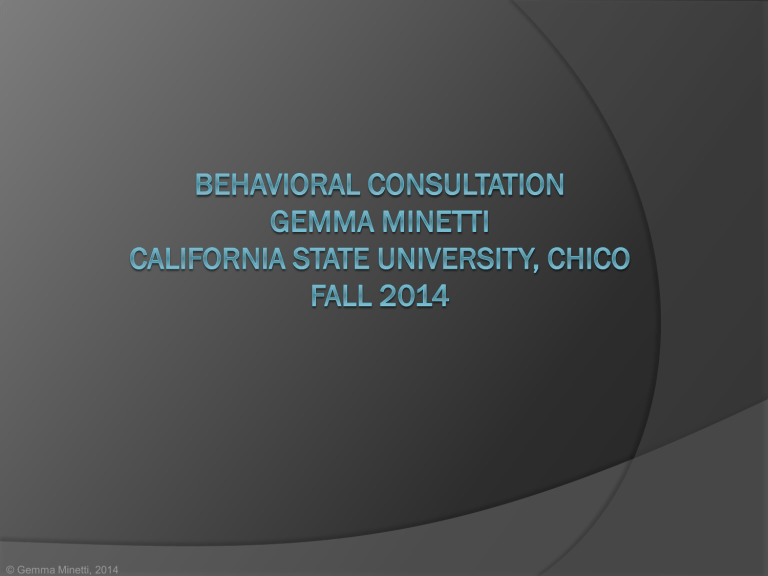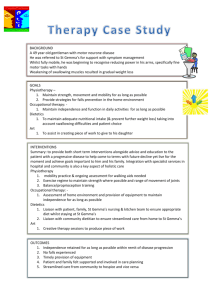Behavioral Consultation Gemma Minetti California

© Gemma Minetti, 2014
Problem Description
K is a six year old first grade student in
Mrs.
P’s general education classroom. K often thinks he knows the answers to Mrs.
P’s verbally asked questions; however, he neglects to raise his hand and wait to be called upon to speak. Instead, K blurts out answers and does not give other students a chance to raise their hand and answer questions.
© Gemma Minetti, 2014
Operational Definition and
Dimension of Behavior
Blurting Out: K will blurt out responses without raising his hand and waiting to be called upon to speak. (excessive)
Decrease Frequency
© Gemma Minetti, 2014
Background Information
K lives in Chico with his two younger brothers, father, and mother, who is pregnant with his younger sister.
He enjoys playing soccer and Wii.
His favorite subject in school is math.
He also likes to play games and climb trees.
Mrs. P described K as a “pleaser” who is extremely helpful and full of energy.
© Gemma Minetti, 2014
Class Schedule: Monday- Thursday
Time
8:30-9:00
9:00-9:55
9:55-10:15
10:15-11:40
11:40-12:30
12:30-12:45
12:45-1:20
1:20-1:30
1:30-2:20
2:20-2:25
Interval (minutes)
30
55
20
85
50
15
35
10
50
5
Activity
Community Time
Word Work
Recess
Reading Groups
Lunch/Recess
Story Time
Language Arts
Recess
Math
Clean Up
Collect data
© Gemma Minetti, 2014
Antecedent
Everyday
Math/ Pick Up prompted to raise hand
© Gemma Minetti, 2014
Behavior Consequence verbal warning
Code redirection blurting out raises hand move clip down to
“Warning” punishment move clip down to
“Teacher's
Choice” lose 5 minutes of recess punishment response cost verbal praise move clip up to
“Wow” move clip up to
“Good Call Home” positive reinforcement
Mrs. P’s Clip Chart
Good Phone
Call Home
WOW!
All Star Student
Warning
Teacher’s
Choice
© Gemma Minetti, 2014
© Gemma Minetti, 2014
Data Sheet
© Gemma Minetti, 2014
Baseline Data
4
3
6
5
2
1
0
12
11
10
9
8
7
1 2
M= 6; SD= 4.2
3
Day
4
© Gemma Minetti, 2014
5
Blurting
© Gemma Minetti, 2014
Procedure:
Differential
Reinforcement of
Limited Responding.
Everyday
Math.
Mrs. P asks a question.
3
4
1
2
5
6
Phase Blurts
Allowed
4
3
4
5*
2
1
New Interval
Begins
(Interval= 25 minutes).
K has X or less blurt outs.
K is immediately reinforced with a prize and verbal praise from Mrs. P.
K has X or more blurt outs.
K is not reinforced.
*Increased based on Phase 1 data
.
© Gemma Minetti, 2014
Intervention Procedure: Phase 1
Differential Reinforcement of Limited
Responding.
Decrease Blurting.
○ 25 minute interval began.
K was reinforced for 4 or less instances of blurting in the 25 minute interval.
K was immediately reinforced with a prize and verbal praise from Mrs. P as soon as the 25 minute interval ended.
K was not reinforced if he had 5 or more instances of blurting in the 25 minute interval.
○ A new 25 minute interval began.
© Gemma Minetti, 2014
Intervention Implementation Data Sheet: Phase 1
© Gemma Minetti, 2014
Intervention: Phase 1
6
5
4
3
2
1
0
9
8
7
12
11
10
M= 8.4; SD= 3.6
6 7 8
Day
9
© Gemma Minetti, 2014
Blurting
Criterion
10
Total Collection
Time= 50 minutes.
Intervention Procedure: Phase 2
Differential Reinforcement of Limited
Responding.
○
○
Decrease Blurting.
○ 25 minute interval began.
K was reinforced for 5 or less instances of blurting in a
25 minute interval.
K was immediately reinforced with a prize and verbal praise from Mrs. P as soon as the 25 minute interval ended.
K was not reinforced if he had 6 or more instances of blurting in the 25 minute interval.
A new 25 minute interval began.
A visual was added to K’s desk to illustrate how many instances of blurting he was allowed in the
25 minute interval.
Mrs. P marked the designated number every time K blurted.
© Gemma Minetti, 2014
Desk Visual
© Gemma Minetti, 2014
Intervention Data: Blurting
7
Phase 1 Phase 2
6
5
4
3
2
1
0
6 7 8 9
Day
10 11 12
© Gemma Minetti, 2014
1st Interval
M= 4.4; SD= 2.1
2nd Interval
M= 3 ; SD= 2
Criterion
Interval= 25 minutes.
Baseline and Intervention Data: Blurting
12
11
10
9
8
7
6
5
4
3
2
1
M= 6;
SD= 4.2
M= 8.4;
SD= 3.6
M= 5;
SD= 4.2
Criterion
Trend
(Based on median data)
0
1 2 3 4 5 6 7 8 9 10 11 12 13 14 15 16 17 18 19 20 21 22 23 24 25 26 27 28 29 30 31 32 33 34 35
Baseline Phase 1 Phase 2 Phase 3 Phase 4 Phase 5 Phase 6
© Gemma Minetti, 2014
Day
Data points represent the total amount of blurts from
Interval 1 and
Interval 2.
© Gemma Minetti, 2014
Program Efficacy
7
6
5
4
3
2
1
0
Baseline
© Gemma Minetti, 2014
16.7% decrease
Phase 2
Blurting
Plan Efficacy
K’s blurting behavior decreased from baseline to the current phase by 16.7%, which means he has blurted on an average of 5 times in one 25 minute interval rather than 6 times.
His blurting behavior from baseline to the current phase still varies at a rate of
4.2.
© Gemma Minetti, 2014
© Gemma Minetti, 2014
Goals
The goal of maintenance is to keep the behavior occurring at a low rate after the intervention has been removed.
The goal of generalization is to have the behavior occur at low rates in other antecedents.
Specifically for K, we want him to blurt at low rates and only receive the reinforcers his classmates receive, as well as blurt at low rates in all class periods.
© Gemma Minetti, 2014
Procedure
Phase 2 of K’s DRL procedure will continue until he meets the criterion for three consecutive days.
The procedure will continue up to Phase 6.
○ K’s visual prompt on his desk will decrease to only show the number of blurts allowed in each phase.
The visual will be completely removed once the reinforcement schedule moves from continuous to intermittent.
Phase
2
3
4
5
6
Days
Required at
Criterion
5
5
5
5
10
Blurts
Allowed in Each
25 Minute
Interval
5
4
3
2
1
© Gemma Minetti, 2014
Data Sheets
Phase 3
Phase 4
© Gemma Minetti, 2014
Data Sheets
Phase 5
Phase 6
© Gemma Minetti, 2014
Desk Visual: Fading
Phase 3
Phase 4
Phase 5
Phase 6
© Gemma Minetti, 2014
Procedure
Maintenance: K’s blurting behavior must remain at criterion in Phase 6 for a period of 10 days in order to move into generalization.
Generalization: K’s reinforcement schedule will move from continuous to intermittent.
Continuous= K was being reinforced after each
25 minute interval if he met the designated criteria.
Intermittent= K will only be reinforced occasionally after each 25 minute interval, even if he meets the criteria for reinforcement every time.
© Gemma Minetti, 2014
Intermittent Reinforcement Schedule
3
4
1
2
5
Day Interval 1
✖
✖
✔
✖
✔
Interval 2
✖
✔
✖
✔
✖
✔
Reinforce if criterion is met.
✖
Do not reinforce, even if criterion is met.
© Gemma Minetti, 2014
Maintenance
K will only be reinforced if he remains at criterion, which is 2 or fewer blurts in the total 50 minute period.
K will be reinforced if he meets the designated criteria immediately once the 50 minute period ends.
Day
6
7
8
9
10
Reinforcement
Schedule
✔
✖
✖
✔
✖
© Gemma Minetti, 2014
Generalization
After maintenance, K’s reinforcers will be thinned each week.
Week 1 : K will be reinforced with verbal praise, moving his clip up the chart, and a prize from
Mrs. P’s prize box every time he meets criterion.
Week 2 : K will be reinforced with verbal praise paired with moving his clip up the chart every time he meets criterion.
Week 3: K will be reinforced with verbal praise paired with moving his clip up the chart intermittently.
© Gemma Minetti, 2014
Questions or Comments:
© Gemma Minetti, 2014







